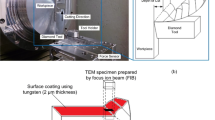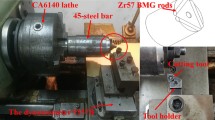Abstract
Bulk metallic glasses (BMGs) have unique properties due to their amorphous atomic structure such as excellent mechanical and thermal performances; BMGs are considered to be promising materials for many engineering applications. However, it is important to investigate the cutting mechanisms of BMG in ultra-precision micro-cutting (UPMC). This study focuses on experimental and theoretical investigations on the chip formation in UPMC of BMG. It was firstly found that twinned-serrated chips (TSCs) are generated in UPMC of BMG. The intrinsic cause is that BMG exhibits significant adiabatic effect, which was confirmed by a proposed finite element model. A series of ultra-precision micro-cutting tests have been carried out to verify the results of simulation and reveal the effect of rake angle on the cutting process of BMG. The simulation and experiment of chip formation proved that the adiabatic effect is the key factor to generate the serrated chips in the UPMC of BMG. In addition, there existed twinned shear in one cyclic of each serrated chip. The comparison between simulation and experiment under the machining condition of different tool rake angles showed that the serrated chip and cutting force are sensitive to the rake angle of tool.











Similar content being viewed by others
References
Bakkal M, Shih AJ, Scattergood RO (2004) Chip formation, cutting forces, and tool wear in turning of Zr-based bulk metallic glass. Int J Mach Tools Manuf 44:915–925
Bakkal M, Shih AJ, Scattergood RO, Liu CT (2004) Machining of a Zr–Ti–Al–Cu–Ni metallic glass. Scr Mater 50:583–588
Hu H, Yan J (2016) Microstructural changes of Zr-based metallic glass during microelectrical discharge machining and grinding by a sintered diamond tool. J Alloys Compd 688:14–21
Bakkal M, Liu CT, Watkins TR, Scattergood RO, Shih AJ (2004) Oxidation and crystallization of Zr-based bulk metallic glass due to machining. Intermetallics 12:195–204
Jiang M, Dai L (2009) Formation mechanism of lamellar chips during machining of bulk metallic glass. Acta Mater 57:2730–2738
Fujita K, Morishita Y, Nishiyama N, Kimura H, Inoue A (2005) Cutting characteristics of bulk metallic glass. Mater Trans 46:2856–2863
Zhu J, Kim HJ, Kapoor SG (2013) Microscale drilling of bulk metallic glass. J Micro Nano-Manuf 1:041004–1–9
Bakkal M, Shih AJ, McSpadden SB, Scattergood RO (2005) Thrust force, torque, and tool wear in drilling the bulk metallic glass. Int J Mach Tools Manuf 45:863–872
Bakkal M, Shih AJ, McSpadden SB, Liu CT, Scattergood RO (2005) Light emission, chip morphology, and burr formation in drilling the bulk metallic glass. Int J Mach Tools Manuf 45:741–752
Huo D (2013) Micro-cutting: fundamentals and applications. John Wiley & Sons
Chen X, Xiao J, Zhu Y, Tian R, Shu X, Xu J (2017) Micro-machinability of bulk metallic glass in UPMC. Mater Des 136:1–12
Han D, Wang G, Li J, Chan KC, Ton S, Wu FF, Gao YL, Zhai QJ (2015) Cutting characteristics of Zr-based bulk metallic glass. J Mater Sci Technol 31:153–158
Chen G, Ren C, Pan Z, Cui K, Li Y (2013) Measurement and finite element simulation of micro-cutting temperatures of tool tip and workpiece. Int J Mach Tools Manuf 75:16–26
Özel T (2006) The influence of friction models on finite element simulations of machining. Int J Mach Tools Manuf 46:518–530
Mahnama M, Movahhedy M (2010) Prediction of machining chatter based on FEM simulation of chip formation under dynamic conditions. Int J Mach Tools Manuf 50:611–620
Wang C, Ding F, Tang D, Zheng L, Li S, Xie Y (2016) Modeling and simulation of the high-speed milling of hardened steel SKD11 (62 HRC) based on SHPB technology. Int J Mach Tools Manuf 108:13–26
Johnson GR, Cook WiH (1983) A constitutive model and data for metals subjected to large strains high strain rates and high temperatures, In Proceeding of the 7th International Symposium on Ballistics, Hague, Netherlands, 21, p 541–547
Yin W (2013) Compressive behavior of bulk metallic glass under different conditions—coupled effect of temperature and strain rate (PhD dissertation). Available from ProQuest Dissertations and Theses database. (UMI No. 3608533)
Johnson GR, Cook WH (1985) Fracture characteristics of three metals subjected to various strains, strain rates, temperatures and pressures. Eng Fract Mech 21:31–48
Author information
Authors and Affiliations
Corresponding author
Additional information
Publisher’s note
Springer Nature remains neutral with regard to jurisdictional claims in published maps and institutional affiliations.
Rights and permissions
About this article
Cite this article
Chau, S.Y., To, S., Sun, Z. et al. Twinned-serrated chip formation with minor shear bands in ultra-precision micro-cutting of bulk metallic glass. Int J Adv Manuf Technol 107, 4437–4448 (2020). https://doi.org/10.1007/s00170-020-04977-9
Received:
Accepted:
Published:
Issue Date:
DOI: https://doi.org/10.1007/s00170-020-04977-9




